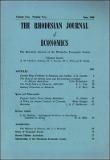| dc.contributor.author | West, J.H. | |
| dc.coverage.spatial | Zimbabwe | en |
| dc.date.accessioned | 2015-08-17T08:14:31Z | |
| dc.date.available | 2015-08-17T08:14:31Z | |
| dc.date.issued | 1968-06 | |
| dc.identifier.citation | West, J.H. (1968) Railway Economics in Rhodesia. Rhodesia Journal of Economnics (RJE), vol 2, no. 2, (pp. 48-59). UZ (formerly University of Rhodesia), Harare (formerly Salisbury) : RES. | en |
| dc.identifier.uri | https://opendocs.ids.ac.uk/opendocs/handle/20.500.12413/6769 | |
| dc.description | A RJE article on the development of railway networks in the then Rhodesia as a precursor to industrial development. | en |
| dc.description.abstract | Until the 19th century land transport was almost entirely dependant on the horse. It was expensive and therefore confined to passengers and high value goods which could stand the cost. With the industrial revolution came a great demand for coal to provide power for the new factories. But the existing roads were unsuitable for heavy loads and colliery owners therefore started building their own roads consisting of double strips of stones spaced to take the wheels of a horse drawn cart. Wood was sometimes used but it tended to rot and was gradually superceded by iron plates, cast iron strips and ultimately wrought iron rails. The extra cost of the iron roads was offset by making them thin and putting flanges on the wheels of the vehicles. Pulling several vehicles in a train spread the cost over a greater load and this was made possible by the reduction in friction due to the special track.
But to obtain greater efficiency it was necessary to employ some traction power much greater and faster than a team of horses. Steam locomotives were gradually introduced but were not too successful because the boilers did not produce enough steam and because it was universally believed that they must have cogged wheels and track. In 1814 the daring innovation of smooth wheels was introduced and a little later Stevenson discovered that a good head of steam could be maintained if the exhaust from the cylinders was led into the furnace and out through the funnel. The turning point was reached in 1825 when Stevenson’s Rocket pulled a train of one coach and 33 wagons from Darlington to Stockton at twelve miles an hour. | en |
| dc.language.iso | en | en |
| dc.publisher | Rhodesian Economic Society (RES). University of Rhodesia (now University of Zimbabwe.) | en |
| dc.rights.uri | http://creativecommons.org/licenses/by-nc-nd/3.0/ | en |
| dc.subject | Economic Development | en |
| dc.subject | Industrial Development | en |
| dc.title | Railway Economics in Rhodesia | en |
| dc.type | Article | en |
| dc.rights.holder | University of Zimbabwe (UZ) (formerly University College of Rhodesia) | en |


